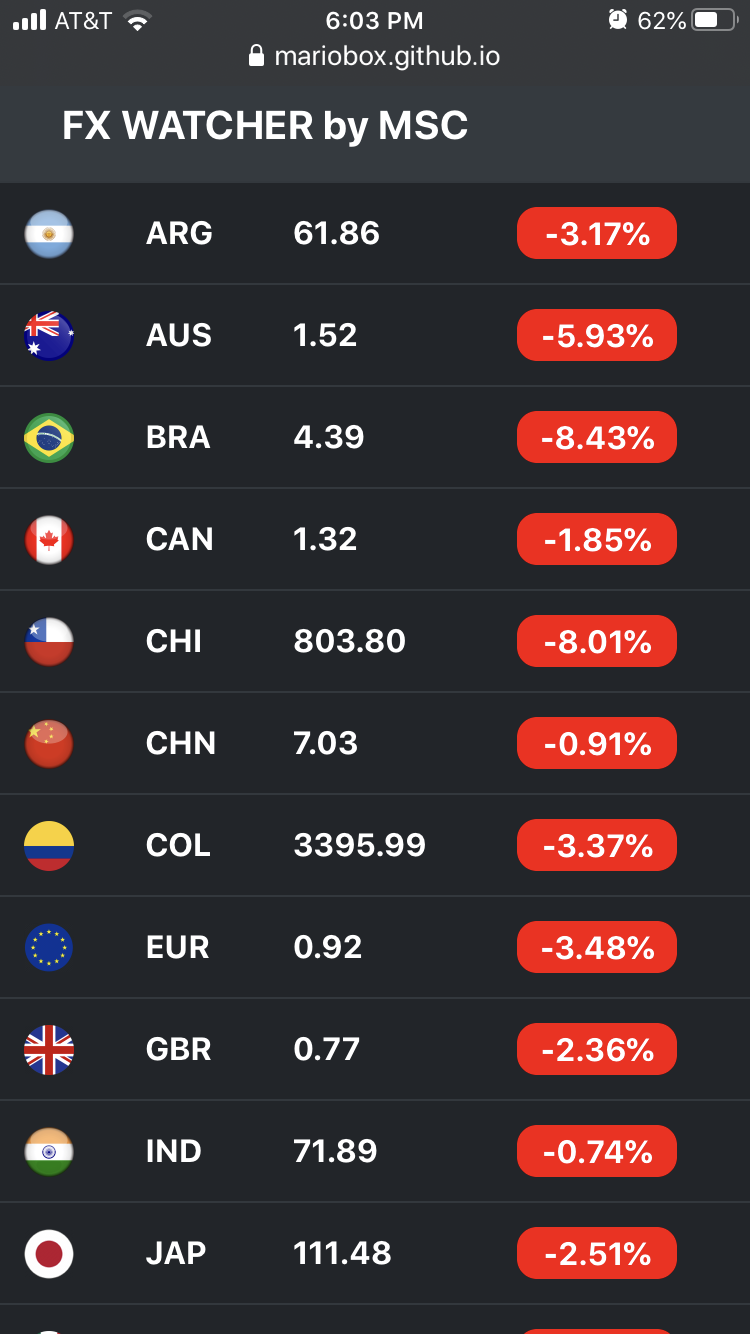
Mario Sanchez Carrion
I am a math tutor currently helping middle and high school students master common math concepts, and getting them prepared for the SAT and ACT tests.
I am also a computer programming enthusiast, especially interested in data analytics using Python, SQL and R.
I previously worked in international marketing and product development for Fortune 500 companies, for more than 25 years.
👋 Contact me at mario@mariosanchez.org.
Foreign Exchange Mobile Web App
Mobile-friendly FX watcher
Made with: JavaScript
Update: The API I was using for this project is not in business any more, so the demo will not work. I am looking for a new API to adapt this project and make it work again.
We will create a mobile web app that will display the current exchange of a basket of currencies versus the US dollar. Besides the current rate we also want to display the YTD % devaluation (or revaluation) for each of the currencies.
I decided to implement this project because I work in international marketing, and devaluation is always an important variable to follow when analyzing business results. I wanted a simple, fast way to browse through the most important currencies for my business, and I wanted it to look good on my phone.
This is how the app looks on my phone:

The HTML is fairly straightforward. Since we wanted a nice styling that worked well in mobile we decided to use of Bootstrap, by including it in the <head> of our home page:
...
<link rel="stylesheet" href="https://maxcdn.bootstrapcdn.com/bootstrap/4.0.0/css/bootstrap.min.css">
...
Another important piece of our home page is a div with the ID of root, where we will place the content generated by our app (i.e. the currency table).
...
<div class="row" id='root'></div>
...
The JavaScript is a little bit more challenging. We used the fetch() method to get info from an external API that provides the exchange rate information. We need two different API calls: one for today’s exchange rate, and another one for the rate on December 31 of the previous year. We need both rates in order to calculate the YTD devaluation percentage:
const url1 =
`https://api.worldtradingdata.com/api/v1/forex?base=USD&api_token=onH6cZpUDVXChT9cbQ6jHuCkgoWPjCmBNRz0Sy5hs4icLbqds5ta1VF0pDpl`;
const url2 =
`https://api.worldtradingdata.com/api/v1/forex_single_day?base=USD&date=${formattedLastYear}&api_token=onH6cZpUDVXChT9cbQ6jHuCkgoWPjCmBNRz0Sy5hs4icLbqds5ta1VF0pDpl`;
const fetchExchange = async () => {
const res = await fetch(url1);
const rates = await res.json();
const resly = await fetch(url2);
const ratesly = await resly.json();
// some other code follows...
}
Notice we’re using async to indicate an asynchronous function, and await to tell the program to wait until it receives all the information from the API before carrying on with the program.
We also created two arrays, one containing the currency abbreviations we want and another one containing country flags that we use in our HTML to make it look nice. Note that the currency symbols have to match exactly the way the API refers to them, or no information will be sent back from their server. We also created two empty array to place the exchange rate values at the current date, and at the last day of the previous year:
let currencies = ["ARS", "AUD", "BRL", "CAD", "CLP", "CNY", "COP", "EUR", "GBP", "INR", "JPY", "MXN", "PEN", "RUB"];
let flags =["img/arg.png", "img/aus.png", "img/bra.png", "img/can.png", "img/chi.png", "img/chn.png", "img/col.png", "img/eur.png", "img/gbr.png", "img/ind.png", "img/jap.png", "img/mex.png", "img/per.png", "img/rus.png"];
let exchanges = [];
let exchangesly = [];
Once we receive the information from the API we have to parse it to a float-since the info coming back from an API is always a string. Then, we use the push() method to add the currency values to their respective arrays:
// Update our arrays with exchange rate data return from fetch calls
for(let i = 0; i < currencies.length; i++) {
exchanges.push(parseFloat(rates.data[currencies[i]]))
}
for(let i = 0; i < currencies.length; i++) {
exchangesly.push(parseFloat(ratesly.data[currencies[i]]))
}
Once we have that information, a for loop iterates over our flags, currencies and exchange rate arrays and builds the HTML container that we will then pass to the <div> with the ID of root in our index.html file:
for (let i = 0; i < l; i++) {
exchanges[i] - exchangesly[i] < 0 ? bkchangely = "#00CC00": bkchangely = "#FF0000";
html += `<tr>
<th scope="row"><img src="${flags[i]}" width="25px"</th>
<td><strong>${currencies[i]}</strong></td>
<td><strong>${exchanges[i].toFixed(2)}</strong></td>
<td><p class="change" style="background-color:${bkchangely}"><strong>${(((exchanges[i] - exchangesly[i])/exchanges[i])*100*(-1)).toFixed(2)}%</strong></p></td>
</tr>`
}
// Build our table
html = `<table class="table table-dark"><tbody>${html}</tbody></table>`;
// Display our table
document.getElementById("root").innerHTML = html;
Finally, we call our fetchExchange() function to set the program in motion and deliver our table to the browser.
All this will make more sense when you review the full source files available in Github.
© 2025 Mario Sanchez Carrion